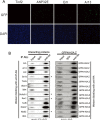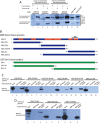Genome-wide identification of histone H2A and histone variant H2A.Z-interacting proteins by bPPI-seq
- PMID: 28862252
- PMCID: PMC5630678
- DOI: 10.1038/cr.2017.112
Genome-wide identification of histone H2A and histone variant H2A.Z-interacting proteins by bPPI-seq
Abstract
H2A is a nucleosome core subunit involved in organizing DNA into a chromatin structure that is often inaccessible to regulatory enzymes. Replacement of H2A by its variant H2A.Z renders chromatin accessible at enhancers and promoters. However, it remains unclear how H2A.Z functions so differently from canonical H2A. Here we report the genome-wide identification of proteins that directly interact with H2A and H2A.Z in vivo using a novel strategy, bPPI-seq. We show that bPPI-seq is a sensitive and robust technique to identify protein-protein interactions in vivo. Our data indicate that H2A.Z-interacting proteins and H2A-interacting proteins participate in distinct biological processes. In contrast to H2A-interacting proteins, the H2A.Z-interacting proteins are involved in transcriptional regulation. We found that the transcription factor Osr1 interacts with H2A.Z both in vitro and in vivo. It also mediates H2A.Z incorporation to a large number of target sites and regulates gene expression. Our data indicate that bPPI-seq can be widely applied to identify genome-wide interacting proteins under physiological conditions.
Figures







Similar articles
-
Catching global interactions in vivo.Cell Biosci. 2017 Sep 29;7:49. doi: 10.1186/s13578-017-0177-z. eCollection 2017. Cell Biosci. 2017. PMID: 29021892 Free PMC article.
-
H2A.Z Represses Gene Expression by Modulating Promoter Nucleosome Structure and Enhancer Histone Modifications in Arabidopsis.Mol Plant. 2017 Oct 9;10(10):1274-1292. doi: 10.1016/j.molp.2017.09.007. Epub 2017 Sep 23. Mol Plant. 2017. PMID: 28951178
-
Variant histone H2A.Z is globally localized to the promoters of inactive yeast genes and regulates nucleosome positioning.PLoS Biol. 2005 Dec;3(12):e384. doi: 10.1371/journal.pbio.0030384. Epub 2005 Nov 1. PLoS Biol. 2005. PMID: 16248679 Free PMC article.
-
Dynamics of histone variant H3.3 and its coregulation with H2A.Z at enhancers and promoters.Nucleus. 2014 Jan-Feb;5(1):21-7. doi: 10.4161/nucl.28067. Epub 2014 Feb 3. Nucleus. 2014. PMID: 24637397 Free PMC article. Review.
-
Reuniting the contrasting functions of H2A.Z.Biochem Cell Biol. 2006 Aug;84(4):528-35. doi: 10.1139/o06-077. Biochem Cell Biol. 2006. PMID: 16936825 Review.
Cited by
-
Catching global interactions in vivo.Cell Biosci. 2017 Sep 29;7:49. doi: 10.1186/s13578-017-0177-z. eCollection 2017. Cell Biosci. 2017. PMID: 29021892 Free PMC article.
-
The high mobility group protein HMG20A cooperates with the histone reader PHF14 to modulate TGFβ and Hippo pathways.Nucleic Acids Res. 2022 Sep 23;50(17):9838-9857. doi: 10.1093/nar/gkac766. Nucleic Acids Res. 2022. PMID: 36124662 Free PMC article.
-
The histone variant H2A.Z in gene regulation.Epigenetics Chromatin. 2019 Jun 14;12(1):37. doi: 10.1186/s13072-019-0274-9. Epigenetics Chromatin. 2019. PMID: 31200754 Free PMC article. Review.
-
Genome-Wide Identification of Trachinotus ovatus Antimicrobial Peptides and Their Immune Response against Two Pathogen Challenges.Mar Drugs. 2023 Sep 25;21(10):505. doi: 10.3390/md21100505. Mar Drugs. 2023. PMID: 37888440 Free PMC article.
-
The Genome-Wide EMS Mutagenesis Bias Correlates With Sequence Context and Chromatin Structure in Rice.Front Plant Sci. 2021 Mar 24;12:579675. doi: 10.3389/fpls.2021.579675. eCollection 2021. Front Plant Sci. 2021. PMID: 33841451 Free PMC article.
References
-
- Faast R, Thonglairoam V, Schulz TC, et al. Histone variant H2A.Z is required for early mammalian development. Curr Biol 2001; 11:1183–1187. - PubMed
-
- Clarkson MJ, Wells JR, Gibson F, Saint R, Tremethick DJ. Regions of variant histone His2AvD required for Drosophila development. Nature 1999; 399:694–697. - PubMed
-
- Barski A, Cuddapah S, Cui K, et al. High-resolution profiling of histone methylations in the human genome. Cell 2007; 129:823–837. - PubMed
MeSH terms
Substances
LinkOut - more resources
Full Text Sources
Other Literature Sources
Molecular Biology Databases

